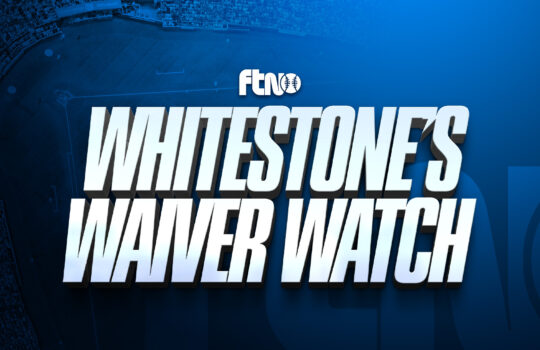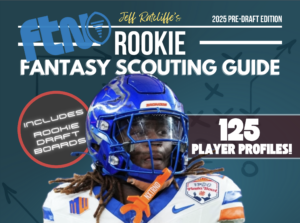
If you’re reading this right now, I assume you are still competing for a fantasy baseball championship. Inhale, exhale. Spend a moment and really take it in. I’ve been playing fantasy sports competitively for multiple decades, and there’s still nothing more fulfilling than a fantasy baseball title.
Even if you don’t win it all – perhaps you’re playing for second or third – there’s something about the end of the baseball season that feels like the end of a year-long war. If you take a look at the team you drafted, then look at your team now, you might not even recognize it. There are so many moves, swaps, trades, FAAB pickups, streams, flip-flops, categorical substitutions, emotional tirades, point-chases, “I accidentally left this guy in my lineup when he’s on the IL” mistakes that go into a near-six month journey.
And yet every single one of them contributed in some way toward the final result. The managers who maximized more than they minimized are usually the last ones standing. So if you’re one of those managers, and you’re still competing for a championship, really savor it. It doesn’t happen often. Though, I’d argue the best managers are able to stay in contention more often than not.
That’s because they are adept at several items:
- Identifying trends
- Recognizing patterns
- Using psychology to their advantage
- Staying level-headed
- Assessing their team’s strengths/weaknesses
- Making adjustments
- Knowing when to add/drop
- Maximizing counting stats
- Creating their own “luck”
And of course, one other item – actual luck.
I’ve discussed many of these topics in depth throughout the season. So I’m incredibly proud to see that many subscribers are still active in our FTN Discord. I’m still fighting for the top spot in a handful of leagues as well, so there’s still a bit more work to do.
However, with this being the final Small Ball article of the year, I’d like to spend some time going through my takeaways from the 2024 fantasy baseball season. There’s no more actionable advice to give that hasn’t been discussed already. So we must look toward the future. After all, there will be another fantasy baseball season in 2025. And if you want to be in contention again next fall, it’s important that we review what worked/what didn’t work in 2024.
In case you missed it, I examined what would have been the perfect draft two weeks ago. This article will piggyback off that in some capacity, so make sure to go back and read that if you haven’t already. Now that we’ve gotten that out of the way, here are some of my biggest takeaways from the 2024 fantasy baseball season.
On Pitching: Wait, Wait And Wait Some More
I mentioned it already, but in my “Perfect Draft” article, I listed a handful of players who you could have drafted post-Round 23 to fill out your bench. Not surprisingly, many of them were starting pitchers.
Here’s a sample:
- Paul Skenes, Pittsburgh Pirates
- Michael Wacha, Kansas City Royals
- Jack Flaherty, Los Angeles Dodgers
- Gavin Stone, Los Angeles Dodgers
- Sean Manaea, New York Mets
- Ranger Suárez, Philadelphia Phillies
- Reynaldo López, Atlanta Braves
- Tanner Houck, Boston Red Sox
- Jared Jones, Pittsburgh Pirates
- Garrett Crochet, Chicago White Sox
- Luis Gil, New York Yankees
That would have been a hell of a pitching staff this year. And none of them (based on ADP) were being drafted in 23-round NFBC Rotowire Online Championships. That’s absolutely wild, but it’s something I discussed in one of my first articles back in December.
In NFBC contests, you should almost always wait on pitching. That’s my stance. There are injuries galore. There will always be pitchers facing the White Sox. Two-step streamers are extremely valuable if carefully deployed. Mid-tier pitchers will emerge and have career seasons. Rookies will come up and dominate for stretches. A veteran pitcher will put together a renaissance season. Post-hype pitchers will end up optimal.
Many of those rules apply to the list of pitchers above. And those are just the ones who were going undrafted. I’d much rather build a sturdy foundation throughout my batting order than take shots at pitching early in drafts. Perhaps one of these years, the script will flip and all the early-round pitchers will carry managers to the top of the overall standings. I’ve yet to see evidence of that.
Position players typically will play 5-6 times per week. Even the top starting pitchers will only make appearances in your lineup once or twice per week – and more often, just once. In a game that requires consistent production across the board to be successful, the cost of drafting pitchers early simply isn’t worth it. Next year, I’ll be deploying a hitter-extreme strategy, like I have for the last several years.
Curtail Your Early FAAB Spending
Having a sound strategy when it comes to FAAB is one of the most crucial aspects of this great game. You only get $1,000 for roughly 27 weeks of free-agent spending. That comes out to an average of $37 dollars per week. So when I went back and looked at some of the early-season bids in my NFBC auction league, there were some laughers.
- Christian Scott ($335)
- José Buttó ($215)
- Kyle Manzardo ($198)
- Andy Pages ($111)
- Andy Pages ($121 – a second time!)
- Connor Joe ($75)
I’d argue those are moves that crippled managers. They were players who ended up virtually unusable and simultaneously strapped them for cash that they could have used for production later in the season. Speaking of later in the season, here are a pair of doozies that really harmed a team that was (at the time) leading in the standings:
- Rece Hinds ($311)
- Juan Yepez ($147)
The bid on Hinds came after his massive home-run binge – meaning, the manager in question didn’t get that production, burned $311 FAAB dollars and never heard from Hinds again (he was sent to the minors the following week and never returned). Yepez, though reasonably productive at times, was not worth that type of high bid.
The pattern here is that most managers aren’t frugal enough with their FAAB money. There are times to go “all-in” on a player. In my mind, those should be players who have many (if not all) of these characteristics:
- Locked-in job security
- Proven production
- Excellent team environment
- Massive pedigree
- Value at a premium position
- Value in a scare category
Let’s use Christian Scott for example. One manager spent $335 FAAB on him back on May 5. That’s really, really early in the season. Though Scott was a high-pedigree prospect, he lacked proven major league production, was pitching on (at the time) an average team, did not provide value at a premium position, did not provide value in any “scarce” categories and did not have locked-in job security.
That’s too many strikes, pun intended, against Scott. Not only that, even if he did stay with the Mets and pitched well throughout the season, was it worth 33% of your budget for the entire season? That’s quite a steep price to pay. Unless you’re gifted an opportunity at a generational prospect (which is unlikely, since those types of players typically are drafted late as dart-throws), or a proven player suddenly becomes available on the free-agent market early in the season, it’s best to remain patient and conservative with your cash.
You can always use cheap conditional bids to grab:
- Two-step pitchers in good matchups
- Proven players who have struggled early
- Categorical boosts (think Jose Caballero for steals)
- Speculation adds
Those will come at a cheaper price tag and have nearly the same odds to produce season-long value without blowing a hole in your wallet. Trust me, you might need that money later in the season when roster strengths/weaknesses are more clearly defined.
Learn to Handle Your Emotions
It’s generally accepted that both men and women should be open and communicative with their emotions. Coming from someone with life experience, it’s better that way. Luckily, there are still ways in which we can stubbornly stuff those emotions down and hold them in for no one else to see.
Fantasy baseball is one of those arenas to keep your emotions in check. While this might be more relevant in season-long leagues that allow trading, it can also be applied to NFBC leagues. Remember Aaron Judge’s start to the season? It’s hard to believe, but Judge was struggling mightily for over a month to begin his 2024 possible MVP campaign.
To a lesser degree, there were calls for Eugenio Suárez to be sent down to the minor leagues. Since then, almost no third baseman has been hotter than Suárez. On that same Diamondbacks team, Corbin Carroll managers were lamenting their decision to take him in the first round. While he won’t live up to his first-round draft capital, he’s yet another example of a player who has taken off in the second half and provided elite production.
Remember when Hunter Brown coughed up roughly 36 runs in the first inning back in April against the Kansas City Royals? Well, what if I told you he’d finish the year with double-digit wins, a sub 4.00 ERA and close to 175 strikeouts? Those who gave up on Brown, traded him or outright dropped him after that start are surely regretting that decision.
Just like in Week 1 of the fantasy football season, we as a fantasy community love to overreact to small sample sizes. If you find yourself getting ready to “rage drop” a player, take a step back and remember the previous paragraph. Conversely, take the opportunity to prey on an opponent who is displaying these types of volatile emotions. We want to keep our emotions in check whenever possible. Trust the data (perhaps your struggling player has been unlucky, and therefore should experience some positive regression). More often than not, we should trust a player’s proven track record. And mostly, trust that over the course of the season, things won’t be as good (or bad) as they are at that very moment.
Analyze Your Own Performance
This last section is extremely important. When the calendar flips to October, most of us are like kids who hear their teacher say “pencils down” at the end of a standardized test. We exit out of our fantasy baseball app, uninstall it until March and forget about the previous season.
Whether you win money or not, it’s best to grade yourself as a fantasy baseball manager. Go back and look at your FAAB pickups. Go back and analyze the draft. Check back on trades. See if you missed opportunities. Write down the times you capitalized on other’s mistakes. But most importantly, just keep a general log of what you did right and what you could improve on for next season.
Recognizing the moves that helped you “win” a title this year can only be reapplied if you are aware of them in the first place. Repeating healthy habits will give you the best chance to repeat success. Conversely, repeating bad habits will only hinder you from season to season until you recognize them and trim down the fat.
While I’m writing this, I realized something rather humorous. I’ve never actually taken my own advice. This all sounds smart and logical in theory, but I’ve never actually kept a log and graded myself on my performance from year to year. As soon as I put my pencil down (er, I mean, keyboard), I’m going to commit to starting my own log. That way, when I start preparing for next year’s season, I’ll be able to review what went right, what went wrong and how I want to adjust moving forward.
You are often your own best critic. You are often your own worst enemy. Analyzing your own performance can help guard against the latter.
Final Thoughts
That does it for this year’s Small Ball series. I want to thank anyone who’s been with me all season long. I hope you’re popping bottles as the calendar flips to October and worrying about other things – such as who to start or sit in your fantasy football league. For anyone interested in that, head over to the FTN Fantasy Football Discord where Adam Strangis and I are answering questions virtually 24/7. And of course, don’t be a stranger in the FTN Fantasy Baseball Discord, either. We’ll still be providing content throughout the offseason to help you prepare for next season.
















































 New York Jets
New York Jets  New England Patriots
New England Patriots  Miami Dolphins
Miami Dolphins  Buffalo Bills
Buffalo Bills  Pittsburgh Steelers
Pittsburgh Steelers  Cleveland Browns
Cleveland Browns  Cincinnati Bengals
Cincinnati Bengals  Baltimore Ravens
Baltimore Ravens  Tennessee Titans
Tennessee Titans  Jacksonville Jaguars
Jacksonville Jaguars  Indianapolis Colts
Indianapolis Colts  Houston Texans
Houston Texans  Las Vegas Raiders
Las Vegas Raiders  Los Angeles Chargers
Los Angeles Chargers  Kansas City Chiefs
Kansas City Chiefs  Denver Broncos
Denver Broncos  Washington Commanders
Washington Commanders  Philadelphia Eagles
Philadelphia Eagles  New York Giants
New York Giants  Dallas Cowboys
Dallas Cowboys  Minnesota Vikings
Minnesota Vikings  Green Bay Packers
Green Bay Packers  Detroit Lions
Detroit Lions  Chicago Bears
Chicago Bears  Tampa Bay Buccaneers
Tampa Bay Buccaneers  New Orleans Saints
New Orleans Saints  Carolina Panthers
Carolina Panthers  Atlanta Falcons
Atlanta Falcons  San Francisco 49ers
San Francisco 49ers  Seattle Seahawks
Seattle Seahawks  Los Angeles Rams
Los Angeles Rams  Arizona Cardinals
Arizona Cardinals 










 Boston Celtics
Boston Celtics  Brooklyn Nets
Brooklyn Nets  Philadelphia 76ers
Philadelphia 76ers  New York Knicks
New York Knicks  Toronto Raptors
Toronto Raptors  Chicago Bulls
Chicago Bulls  Detroit Pistons
Detroit Pistons  Milwaukee Bucks
Milwaukee Bucks  Cleveland Cavaliers
Cleveland Cavaliers  Indiana Pacers
Indiana Pacers  Orlando Magic
Orlando Magic  Atlanta Hawks
Atlanta Hawks  Charlotte Hornets
Charlotte Hornets  Miami Heat
Miami Heat  Washington Wizards
Washington Wizards  Denver Nuggets
Denver Nuggets  Minnesota Timberwolves
Minnesota Timberwolves  Oklahoma City Thunder
Oklahoma City Thunder  Portland Trail Blazers
Portland Trail Blazers  Utah Jazz
Utah Jazz  LA Clippers
LA Clippers  Golden State Warriors
Golden State Warriors  Los Angeles Lakers
Los Angeles Lakers  Phoenix Suns
Phoenix Suns  Sacramento Kings
Sacramento Kings  Dallas Mavericks
Dallas Mavericks  Houston Rockets
Houston Rockets  Memphis Grizzlies
Memphis Grizzlies  New Orleans Pelicans
New Orleans Pelicans  San Antonio Spurs
San Antonio Spurs 














